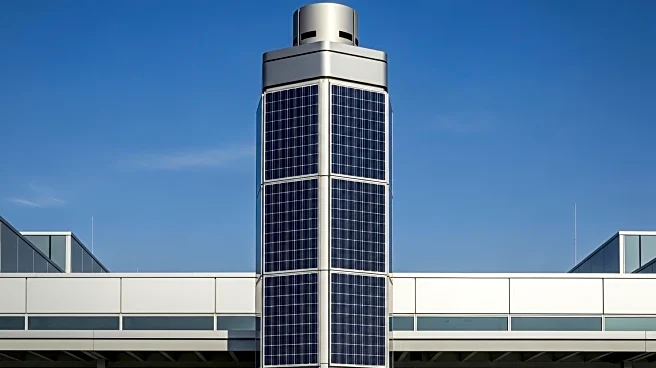What's Happening?
Cologne-Bonn Airport in Germany has initiated a pilot project involving the installation of adhesive solar panels on a 27-meter chimney at its co-generation plant. The system comprises 80 panels with a collector area of approximately 70 square meters, generating up to 4,400 kWh annually, equivalent to the energy consumption of a household. Developed by Heliatek, these panels utilize a rear adhesive, eliminating the need for a substructure. Each panel has an efficiency of 7.2% to 8.0% and a power output of 50 W to 55 W. The airport is also exploring emission-free heating and cooling solutions, including ice banks and heat pumps, alongside investments in an electrical substation and a wood-pellet power plant.
Why It's Important?
The implementation of adhesive solar panels at Cologne-Bonn Airport represents a significant step towards sustainable energy solutions in aviation infrastructure. By utilizing innovative technology, the airport aims to enhance its energy efficiency and reduce carbon emissions. This project could serve as a model for other airports and industries seeking to integrate renewable energy sources into their operations. The broader adoption of such technologies may contribute to global efforts in combating climate change and promoting environmental sustainability.
What's Next?
The success of this pilot project may encourage further investments in renewable energy technologies at Cologne-Bonn Airport and potentially other airports worldwide. As the airport continues to develop its emission-free heating and cooling systems, it may explore additional partnerships and technologies to expand its sustainable energy initiatives. The outcomes of this project could influence policy decisions and industry standards regarding energy efficiency in aviation.
Beyond the Headlines
The use of adhesive solar panels highlights the potential for innovative solutions in overcoming structural limitations of conventional photovoltaic systems. This approach may pave the way for broader applications in urban environments where space and structural constraints are prevalent. The project also underscores the importance of collaboration between technology developers and infrastructure operators in advancing sustainable practices.











